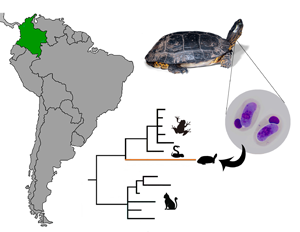Crossref Citations
This article has been cited by the following publications. This list is generated based on data provided by
Crossref.
de Paula, Fabiane R.
Picelli, Amanda M.
Perles, Lívia
André, Marcos R.
and
Viana, Lúcio A.
2022.
A 50-year-old redescription: molecular and morphometric characterization of Hepatozoon carinicauda Pessôa and Cavalheiro, 1969 in the brown-banded water snake Helicops angulatus (Linnaeus, 1758).
Parasitology,
Vol. 149,
Issue. 11,
p.
1468.
Correa, Jamille Karina Coelho
Picelli, Amanda Maria
da Silva, Maria Regina Lucas
Valadão, Rafael Martins
Hernández-Ruz, Emil José
and
Viana, Lúcio André
2022.
Phylogenetic analysis of chelonian hemogregarines reveals shared species among the Amazonian freshwater turtle Podocnemis spp. and provides a description of two new species of Haemogregarina.
Parasitology Research,
Vol. 121,
Issue. 2,
p.
691.
Zechmeisterová, Kristína
Přibyl, Michal
Manh Nguyen, Hung
Nosková, Eva
and
Široký, Pavel
2022.
Haemogregarines of the Genera Haemogregarina, Hemolivia, and Hepatozoon Infecting Vietnamese Freshwater Turtles, with Additional Notes on Primer Specificity and Primer-template Mismatches Affecting Diagnostic Success.
Protist,
Vol. 173,
Issue. 4,
p.
125884.
Chang, Yen-Chi
Lin, Tai-Shen
Huang, Wei-Wen
Lee, Hung-Yi
Shih, Cheng-Hsin
Wu, Ying-Chen
Huang, Chiu-Chen
and
Chen, Ter-Hsin
2023.
Reevaluation of Hemoparasites in the Black Spiny-Tailed Iguana (Ctenosaura similis) with the First Pathological and Molecular Characterizations of Lankesterella desseri n. sp. and Redescription of Hepatozoon gamezi.
Microorganisms,
Vol. 11,
Issue. 10,
p.
2374.
PICELLI, AMANDA MARIA
SILVA, MARIA REGINA L.
CORREA, JAMILLE KARINA C.
PAIVA, GLEICIERLE R.
PAULA, FABIANE R.
HERNÁNDEZ-RUZ, EMIL JOSÉ
OLIVEIRA, ELCIOMAR A.
and
VIANA, LÚCIO ANDRÉ
2023.
Hepatozoon Miller, 1908 parasites in the Colubridae snakes Clelia clelia (Daudin, 1803) and Drymarchon corais (Boie, 1827) from the Eastern Amazonia.
Anais da Academia Brasileira de Ciências,
Vol. 95,
Issue. suppl 1,
Parejo-Pulido, Daniel
Mora-Rubio, Carlos
Marzal, Alfonso
and
Magallanes, Sergio
2023.
Molecular characterization of haemosporidian and haemogregarine diversity in southwestern Iberian amphibians and reptiles.
Parasitology Research,
Vol. 122,
Issue. 5,
p.
1139.
Úngari, Letícia Pereira
Santos, André Luiz Quagliatto
da Silva, Reinaldo José
and
O’Dwyer, Lucia Helena
2023.
Hemogregarine Diversity Infecting Brazilian Turtles with a Description of Six New Species of Haemogregarina (Apicomplexa: Adeleorina: Haemogregarinidae).
Diversity,
Vol. 15,
Issue. 2,
p.
296.
Chisu, Valentina
Giua, Laura
Bianco, Piera
Masala, Giovanna
Sechi, Sara
Cocco, Raffaella
and
Piredda, Ivana
2023.
Molecular Survey of Hepatozoon canis Infection in Domestic Dogs from Sardinia, Italy.
Veterinary Sciences,
Vol. 10,
Issue. 11,
p.
640.
Megía-Palma, Rodrigo
Martínez, Javier
Fitze, Patrick S.
Cuervo, José J.
Belliure, Josabel
Jiménez-Robles, Octavio
Cabido, Carlos
Martín, José
and
Merino, Santiago
2023.
Genetic diversity, phylogenetic position, and co-phylogenetic relationships of Karyolysus, a common blood parasite of lizards in the western Mediterranean.
International Journal for Parasitology,
Vol. 53,
Issue. 4,
p.
185.
Thomas, Richard
Santodomingo, Adriana
Saboya-Acosta, Liliana
Quintero-Galvis, Julian F.
Moreno, Lucila
Uribe, Juan E.
and
Muñoz-Leal, Sebastián
2024.
Hepatozoon (Eucoccidiorida: Hepatozoidae) in wild mammals of the Americas: a systematic review.
Parasites & Vectors,
Vol. 17,
Issue. 1,
Mofokeng, Lehlohonolo S.
Netherlands, Edward C.
Smit, Nico J.
and
Cook, Courtney A.
2024.
Developmental stages and molecular phylogeny of Hepatozoon fitzsimonsi (Dias 1953) (Adeleorina: Hepatozoidae) in tortoises Stigmochelys pardalis (Cryptodira: Testudinidae) and ticks of the genus Amblyomma (Acari: Ixodidae) from South Africa.
Parasites & Vectors,
Vol. 17,
Issue. 1,
Mansour, Reda M.
2025.
Morphometrics and First Ultrastructural Characterizations of Intra‐Erythrocytic Stages of So‐Called Haemogregarina damiettae Ramadan et al. (1996) With Special Reference to Its Cytopathological Effects on the Infected Erythrocytes.
Microscopy Research and Technique,
Vol. 88,
Issue. 5,
p.
1501.
